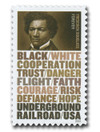
# 5841 - 2024 First-Class Forever Stamp - Frederick Douglass, Underground Railroad
US #5841
2024 Frederick Douglass – Underground Railroad
• Honors Frederick Douglass, his escape to freedom and his later good deeds through the Underground Railroad
Stamp Category: Commemorative
Set: Underground Railroad
Value: 68¢ First Class Mail Rate (Forever)
First Day of Issue: March 9, 2024
First Day City: Church Creek, Maryland
Quantity Issued: 20,000,000
Printed by: Ashton Potter (USA) Ltd.
Printing Method: Offset
Format: Panes of 20
Watermark: Nonphosphored Type III, Block Tag Applied
Why the stamp was issued: To commemorate Black abolitionist, civil rights leader, writer, and speaker Frederick Douglass who escaped slavery through the Underground Railroad.
About the stamp design: Pictures a sepia-toned portrait of Frederick Douglass along with eight lines of text which read: BLACK/WHITE; COOPERATION; TRUST/DANGER; FLIGHT/FAITH; COURAGE/RISK; DEFIANCE/HOPE; UNDERGROUND; RAILROAD/USA. Designed by Antonio Alcalá using an existing image.
Special design details: On the reverse side of the pane of 20, there is a map picturing routes taken on the Underground Railroad from the South to North. The reverse side also includes a list of people pictured on the stamps plus biographical information on them.
First Day City: The First Day of Issue Ceremony was held at the Harriet Tubman Underground Railroad Visitor Center in Church Creek, Maryland.
About the Underground Railroad set: Pictures 10 people who made their way to freedom or helped others reach freedom through the Underground Railroad. Includes: Harriet Tubman, Thomas Garrett, William Still, Harriet Jacobs, Jermain Loguen, Catherine Coffin, Lewis Hayden, Frederick Douglass, William Lambert, and Laura Haviland.
History the stamp represents: Frederick Douglass (February 1817 or 1818 – February 20, 1895) was a Black abolitionist, civil rights leader, writer, speaker, and much more.
Douglass was born a slave in Maryland, but was able to escape in 1838. He quickly became a big part of the abolitionist and free Black community in the North. Because Douglass was lucky enough to have learned to read as a boy (strictly forbidden in many slave states), he had an advantage over many other former slaves. He became a speaker and writer, finishing his famous autobiography, Narrative of the Life of Frederick Douglass, an American Slave, Written by Himself in 1845. It became a sensation and was especially popular in Europe. Douglass began publishing his newspaper The North Star just a few years later.
After moving to Rochester, New York, Douglass’s home became part of the Underground Railroad. In addition to helping fellow escaped slaves to freedom, Douglass began giving lectures advocating for emancipation. He was even invited to the White House to speak with President Lincoln in 1864.
After the Civil War, Douglass began promoting additional protections and rights for the newly freed Black community. He also supported women’s suffrage. In the end, he devoted his entire life to fighting for a better world for himself and others.
US #5841
2024 Frederick Douglass – Underground Railroad
• Honors Frederick Douglass, his escape to freedom and his later good deeds through the Underground Railroad
Stamp Category: Commemorative
Set: Underground Railroad
Value: 68¢ First Class Mail Rate (Forever)
First Day of Issue: March 9, 2024
First Day City: Church Creek, Maryland
Quantity Issued: 20,000,000
Printed by: Ashton Potter (USA) Ltd.
Printing Method: Offset
Format: Panes of 20
Watermark: Nonphosphored Type III, Block Tag Applied
Why the stamp was issued: To commemorate Black abolitionist, civil rights leader, writer, and speaker Frederick Douglass who escaped slavery through the Underground Railroad.
About the stamp design: Pictures a sepia-toned portrait of Frederick Douglass along with eight lines of text which read: BLACK/WHITE; COOPERATION; TRUST/DANGER; FLIGHT/FAITH; COURAGE/RISK; DEFIANCE/HOPE; UNDERGROUND; RAILROAD/USA. Designed by Antonio Alcalá using an existing image.
Special design details: On the reverse side of the pane of 20, there is a map picturing routes taken on the Underground Railroad from the South to North. The reverse side also includes a list of people pictured on the stamps plus biographical information on them.
First Day City: The First Day of Issue Ceremony was held at the Harriet Tubman Underground Railroad Visitor Center in Church Creek, Maryland.
About the Underground Railroad set: Pictures 10 people who made their way to freedom or helped others reach freedom through the Underground Railroad. Includes: Harriet Tubman, Thomas Garrett, William Still, Harriet Jacobs, Jermain Loguen, Catherine Coffin, Lewis Hayden, Frederick Douglass, William Lambert, and Laura Haviland.
History the stamp represents: Frederick Douglass (February 1817 or 1818 – February 20, 1895) was a Black abolitionist, civil rights leader, writer, speaker, and much more.
Douglass was born a slave in Maryland, but was able to escape in 1838. He quickly became a big part of the abolitionist and free Black community in the North. Because Douglass was lucky enough to have learned to read as a boy (strictly forbidden in many slave states), he had an advantage over many other former slaves. He became a speaker and writer, finishing his famous autobiography, Narrative of the Life of Frederick Douglass, an American Slave, Written by Himself in 1845. It became a sensation and was especially popular in Europe. Douglass began publishing his newspaper The North Star just a few years later.
After moving to Rochester, New York, Douglass’s home became part of the Underground Railroad. In addition to helping fellow escaped slaves to freedom, Douglass began giving lectures advocating for emancipation. He was even invited to the White House to speak with President Lincoln in 1864.
After the Civil War, Douglass began promoting additional protections and rights for the newly freed Black community. He also supported women’s suffrage. In the end, he devoted his entire life to fighting for a better world for himself and others.











